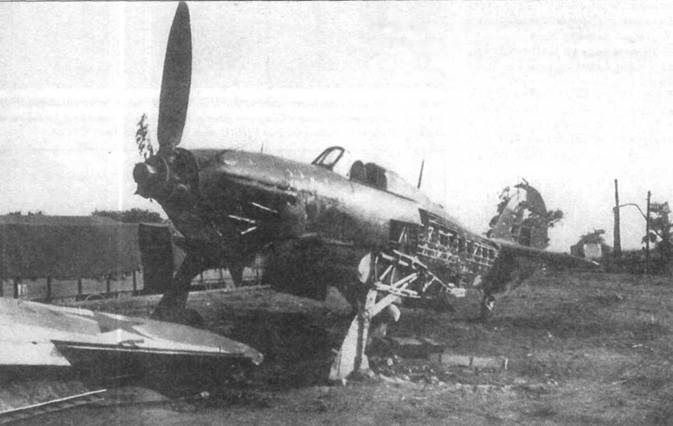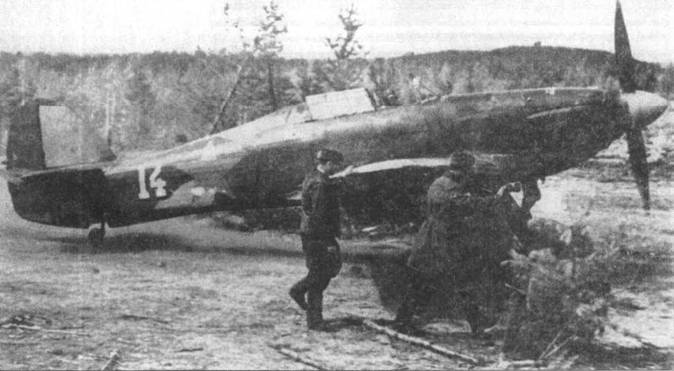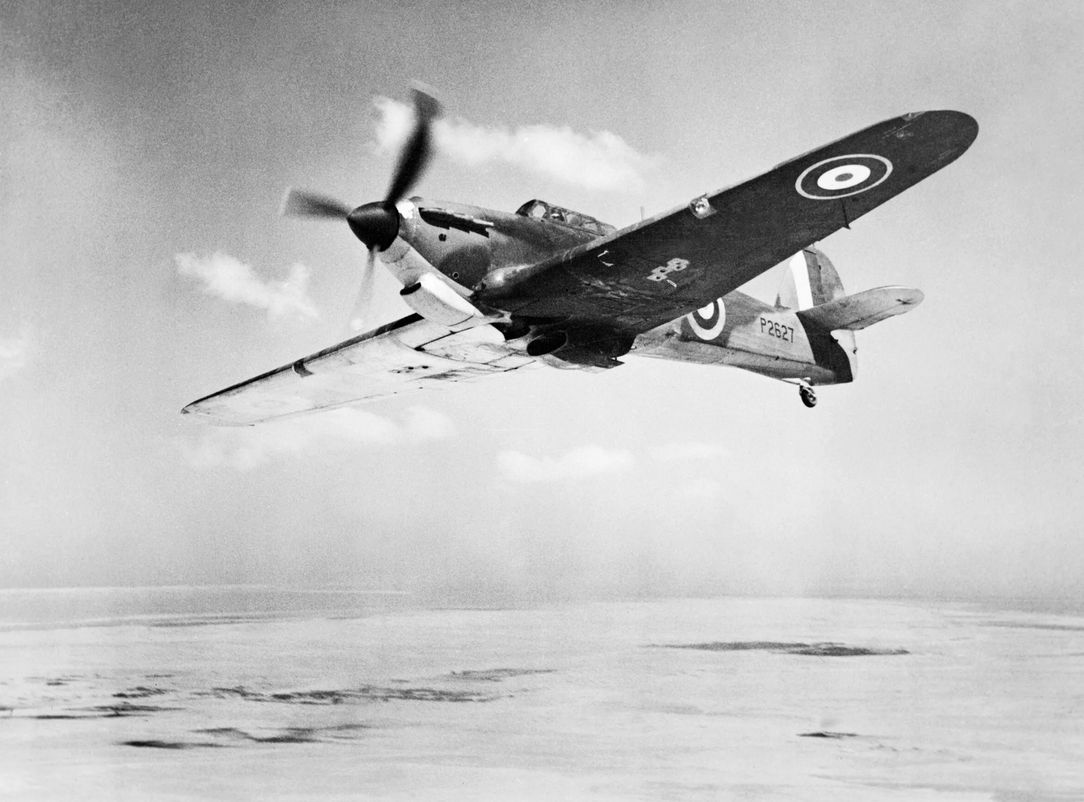Hawker Hurricane WW2 – Better Than the Spitfire?
Hawker Hurricane is a British single-seat fighter aircraft of World War II, developed by Hawker Aircraft Ltd in 1934. With various modifications of the aircraft, it could act as interceptors, fighter-bombers (also known as “Hurribombers”) and attack aircraft. For operations from aircraft carriers, there was a modification called the Sea Hurricane. In total, more than 14,500 copies were built.
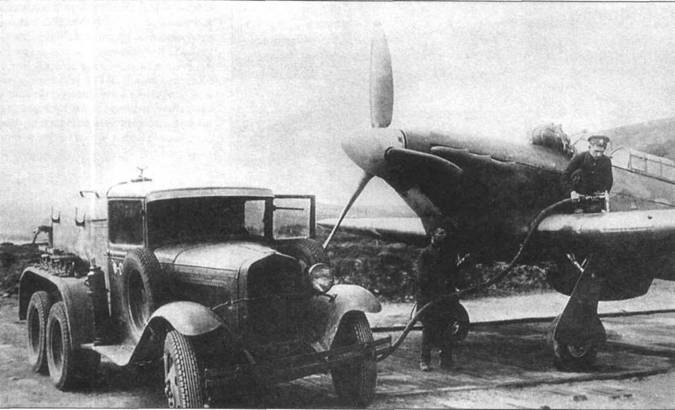
Hawker Hurricane In USSR
The Hurricane was developed by Hawker Aircraft Ltd in response to a request from the Air Ministry to build a fighter aircraft armed with eight machine guns and a new Rolls-Royce PV-12 engine, which would later become known as the Merlin.
At the same time, RAF Fighter Command included 13 squadrons armed with Hawker Fury, Hawker Hart or Bristol Bulldog biplanes with fixed-pitch wooden propellers and fixed landing gear.
The development, begun in early 1934 under the direction of Sidney Camm, was rejected by the Air Ministry, and Camm proposed to release the aircraft as a private initiative of the Hawker company. To save money, the Hurricane was designed using as many existing tools and equipment as possible. In reality, the aircraft was a monoplane version of the successful Hawker Fury. This was a major factor in the subsequent success of the Hurricane.
In the early stages of development, the Fury monoplane was equipped with a Rolls-Royce Goshawk engine, but a little later it was replaced by the Merlin and equipped with retractable landing gear. The development became known as the “monoplane interceptor ” and by May 1934 was ready in detail.
The model was built on a scale of 1:10. A series of tests confirmed that the development’s vital aerodynamic qualities were in order, and a full-size model was built in December of that year.
The first prototype K5083 began to be built in August 1935 with a PV-12 Merlin engine. The completed parts of the aircraft were taken to Brooklands Speedway, where Hawker had an assembly hangar, and assembled on October 23, 1935. Ground testing took about two weeks, and on November 6, 1935, under the control of the chief test pilot of the Hawker PWS, George Bulman (George Bulman), the prototype took off for the first time.
Despite being faster than the biplanes in service with the RAF, the Hurricane was obsolete at the time of its creation. The power frame was made using the same technology as the frame of biplanes, where rivets were preferred to welded joints. It had a trussed fuselage of high-strength steel tubing, to which spars were attached, covered with linen. This design meant the Hurricane’s high strength and greater resistance to explosive projectiles than the metal-plated Supermarine Spitfire. Initially, the wing consisted of two spars and was also covered with fabric. All-metal wing made of duralumin was developed only in April 1939. All subsequent modifications were equipped with such a wing.
Ease of maintenance, wide chassis gauge, good flight characteristics allowed the Hurricane to be widely used in theaters of war, where reliability, ease of control and a stable platform for weapons were more important than flight characteristics, for example, in the role of an attack aircraft.
Hawker Hurricane Production
The Hurricane was sent into mass production as early as June 1936, mainly due to its relative simplicity of design and ease of manufacture. With the prospect of an increasingly likely war, it was important to supply the RAF with an effective fighter as quickly as possible if production of the much more advanced Spitfire ran into difficulties. The same factor was important for squadron maintenance personnel, who had experience in servicing and repairing aircraft of a similar design to the Hurricane, the simplicity of which allowed outstanding improvisation when repairing in squadron workshops.
The first production aircraft with the Merlin II engine installed made its first flight on October 12, 1937. In December, the first four aircraft entered service with 111 Squadron at RAF Northolt. By the beginning of the war, about 500 Hurricanes were produced, with which 18 squadrons were equipped.
Hurricane Modifications
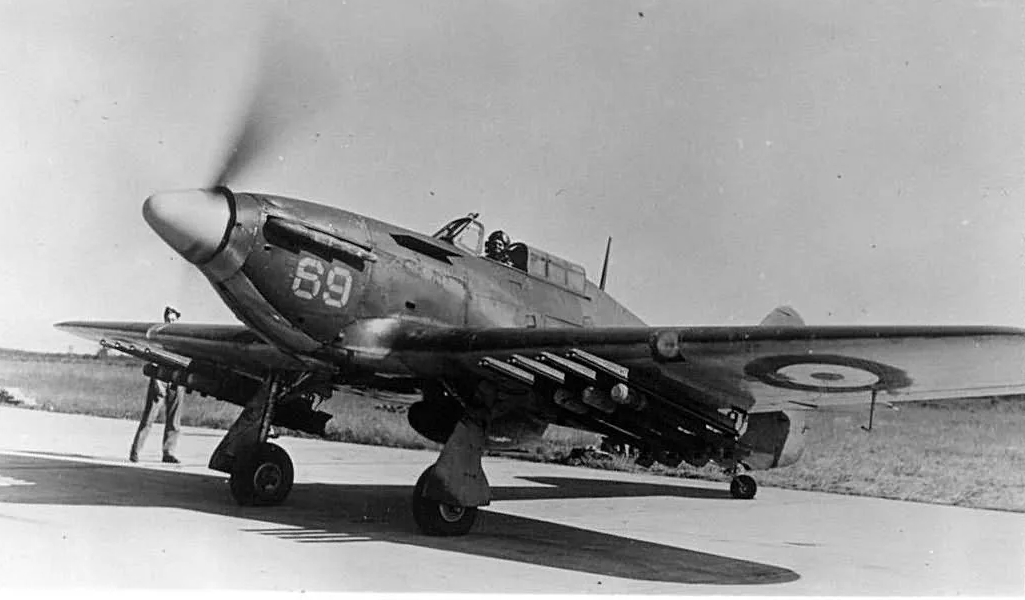
Hawker Hurricane
Hurricane I
First production version with cloth-covered wings, fixed – pitch wooden two-blade propeller. Equipped with a Rolls-Royce Merlin II or III engine with a takeoff power of 880 hp. with. and maximum afterburner power of 1310 hp. with. at an altitude of 2743 m (9000 ft). Armed with eight 7.7 mm Browning.303 Mk II machine guns. Produced in 1937 – 1939 .
Hurricane I (revision)
The revised version of the Hurricane featured a de Havilland or Rotol -built constant-speed metal propeller, a metal-clad wing, improved armor, and other improvements. In 1939, the RAF was armed with about 500 aircraft of this modification, which formed the basis of fighter squadrons.
Hurricane IIA Series 1
Hurricane I powered by a Merlin XX engine with 1280 hp takeoff power. with. and afterburner power of 1490 liters. with. at an altitude of 3,810 m (12,500 ft). Armed with four 20 mm Hispano Mk II cannons. First took to the air June 11, 1940. Entered service with squadrons in September of the same year.
Hurricane IIB (Hurricane IIA Series 2)
Hurricane IIA Series 1 fitted with a new and slightly longer propeller hub fairing. Armed with twelve 7.7 mm Browning.303 Mk II machine guns. In addition, it could carry 2 bombs weighing 250 or 500 pounds, although this negatively affected the maximum flight speed. From 1941, instead of a bomb load, it could carry two external fuel tanks of 205 liters (45 gallons). The first aircraft was built in October 1940, and its name – Mark IIB, it received only in April 1941.
Hurricane IIB Trop.
Tropical variant for use in North Africa. Equipped with dust filters and a desert survival kit for crashed pilots.
Hurricane IIC (Hurricane IIA Series 2)
New propeller hub fairing. Armed with four 20 mm Hispano Mk II cannons. Like the Hurricane IIB, it could additionally take a bomb load or fuel tanks. According to the characteristics, he was inferior to the German fighters, so he switched to assault missions. There have also been attempts to use this modification as a night fighter. The most numerous model, 4711 produced (including converted IIA and IIB).
Hurricane II
Assault modification of the Hurricane IIB. It was armed with two 40 mm anti-tank guns (originally Rolls-Royce QF 2-pounder Mark XIV with 12 rounds per barrel, later Vickers S with 15 rounds per barrel) and two 7.7 mm Browning.303 Mk II machine guns with tracer ammunition. The armor of the cockpit, radiator and engine was also reinforced. The weight of the armament and additional armor had a negative effect on maneuverability and virtually ruled out the use as a fighter. The first aircraft took off on September 18, 1941, and deliveries began in 1942. Actively used in North Africa.
Hurricane II
Hurricane IID variant with unified wing suspension, allowing the use of two 40 mm Vickers S anti-tank guns or eight 60 – pounder RP-3 rockets, in addition to which there were two 7.7 mm Browning.303 Mk II machine guns. Instead of guns and missiles, it could carry two fuel tanks or two bombs. It was not possible to use cannons and rockets under different wings, because the rockets fell off the guides due to recoil during cannon firing. The prototype was successfully tested on March 23, 1942, from April into series production. After the release of 270 pieces, the engine was replaced, the armor was improved, and the model became known as the Hurricane IV.
Hurricane T.IIC
Double training aircraft. Two built for the Persian Air Force.
Hurricane III
Modification of the Hurricane II fitted with a Packard Merlin engine as an alternative to British engines. Not serially produced.
Hurricane IV
Hurricane IIE with 350 lbs (159 kg) of additional cockpit, radiator and fuel tank armor and a Merlin 24 or 27 engine with 1,610 hp takeoff power. with. and a maximum afterburner power of 1510 hp. with. at an altitude of 2819 m (9250 ft). All 524 produced cars were equipped with dust filters.
Hurricane V
An experimental project to equip the Hurricane IV with a four-bladed propeller and a Merlin 32 engine with a take-off power of 1625 hp. with. and a maximum afterburner power of 1640 hp. with. at an altitude of 609 m (2000 ft). Flight performance improved slightly, and the engine had a tendency to overheat. The model was intended for assault operations in Burma. No more than 3 copies were built, which, after testing in April 1943, were converted into Hurricane IV.
Hurricane X
Canadian variant of the Hurricane I powered by a Packard Merlin 28 engine with 1,300 hp takeoff power. with. and a maximum afterburner power of 1240 hp. with. at an altitude of 3505 m (11500 ft). A total of 490 were built.
Hurricane XI
Canadian variant of the Hurricane II. 150 built.
Hurricane XIIA and XII
The Canadian Hurricane XIIA was a variation of the British Hurricane II, while the Canadian XII was a variation of the British IIB or IIC. The engine used was a Merlin 29 made by Packard with traction characteristics similar to the Merlin 28.
Canadian Car & Foundry (CC&F) produced 1451 Hurricanes of all modifications, including those using British engines.
Sea Hurricane
Hurricane Mk I modified by General Aircraft Limited to be launched from transport ship -mounted catapults. Such vessels had the ability to launch planes but not receive them, so if the plane was unable to fly to the land base, the pilot was ejected with a parachute or splashed down next to the ship that picked him up. Unofficially they were called “Hurricats”.
Most of the modified aircraft withdrawn from service on the front lines were in such a deplorable condition that at least one failed due to overloads when launched from a catapult. In total, about 50 units were rebuilt.
Sea Hurricane IB
Version of the Hurricane IIA Series 2 with catapult coils and brake hook. From October 1941 they were used on transport ships converted into aircraft carriers (the so-called merchant aircraft carriers), which could not only launch aircraft, but also receive them. A total of 340 units were rebuilt.
Sea Hurricane IC
Modification of the Hurricane IIB and IIC, equipped with catapult coils, a brake hook and a wing with four 20 mm cannons. Starting from February 1942, about 400 copies were rebuilt.
Sea Hurricane II
Hurricane IIC equipped with a marine transceiver. 400 aircraft were rebuilt and used on fleet aircraft carriers.
Sea Hurricane XIIA
Canadian built Hurricane XIIA converted to Sea Hurricane
Hawker Hurricanes In Service in the USSR
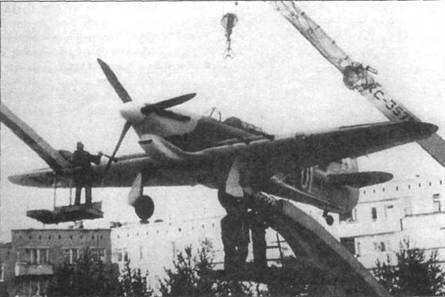
In the second half of 1941, Hurricane fighters began to be massively used in other theaters of war, far from Great Britain. On August 30, 1941, Winston Churchill proposed to Stalin that 200 Hurricane-type fighters be supplied as part of the military assistance program. These vehicles were supposed to be a good addition to a batch of 200 P-40 Tomahawks. At that time, the Soviet Union was glad for any help from the allies, and almost immediately consent was given. According to the plans, these aircraft were supposed to be delivered by sea to Murmansk, where they were assembled and transferred to the Soviet side, but the first Hurricanes got to the USSR in an unusual way.
On August 28, 1941, 24 Mk.IIB Hurricanes from the 151st RAF Wing landed at the Vaenga airfield near Murmansk, taking off from the deck of the aircraft carrier HMS Argus. Soon, 15 more aircraft were added to them, delivered and assembled in Arkhangelsk by British specialists. The British group consisted of two squadrons. The task of the British pilots was to help Soviet pilots master new technology. However, they soon got involved in combat work, in which they patrolled the airspace jointly with Soviet pilots, covering convoys and ports where Western aid arrived.
Interestingly, in the winter of 1941/42, aircraft originally intended for other countries went to arm the Soviet fighter regiments.
In total, about 3 thousand Hurricanes were delivered to the USSR as British military assistance during the war years : at least 210 IIA modification machines, 1557 units – IIB and similar Canadian X, XI, XII (manufactured by the company” Canadian Car and Foundry” and distinguished by a partial set of American equipment), 1009 machines – IIC modifications, 60 aircraft – IID and 30 – type IV. Part of the Type IIA fighters was actually a remake of old Type I machines, carried out by Rolls-Royce. And in the fall of 1942, the Soviet Union even got one “Sea Hurricane” I (number V6881), the so-called “catafighter” (a fighter fired from a catapult for air defense of ships). This aircraft ejected from the Empire Horn transport while covering the ships of the PQ-18 convoy and landed in Arkhangelsk.
It should be noted that in the winter of 1941/42, when most of the Hurricanes were delivered to the USSR, the Soviet Air Force had a huge shortage of modern aircraft. Of course, compared to the I-15 or similar alternatives, the Hurricane was a marvel of modern aviation. However, already at the end of 1941, the Hurricanes were much inferior to the German fighters. With the advent of new Soviet aircraft, the backlog of the Hurricanes became even more noticeable. Therefore, many Soviet mechanics and engineers tried their best to somehow improve the performance of the aircraft. Many weapon changes were made in the field even before the start of the official modernization program. The armor was improved – the standard armored back of the pilot’s seat (two 4-mm steel plates) was replaced with an armored back from the LaGG-3 or with armored seats taken from the I-16.
The 7.62mm Brownings were replaced by 12.7mm UBK machine guns, or by one ShVAK cannon with two 12.7mm machine guns, suspensions for RS-82 missiles. In most regiments, mechanics usually equipped Hurricanes with four or six RS-82s. Problems arose when mechanics tried to use water instead of glycol to cool the engine. Changes were made to the cooling system, but in the end, the Hurricane’s own antifreeze was replaced with Soviet ones, which worked better at low temperatures.
Somewhat apart are the “anti-tank” modifications IID and IV with 40-mm cannons in hanging containers, which arrived in the USSR through Iran in early 1943. The IID Hurricanes entered the Soviet Air Force after they were withdrawn from service with the RAF divisions in North Africa. We never got to their combat use, we can only add that in the spring of 1943 they were used to retrain flight personnel in the North Caucasus.
By the summer of 1942, “Humpbacked”, or “Khariton”, as they were called by Soviet pilots (“ Khariton” – a male name popular in the 19th century), were used in large quantities in the Baltic and Northern Fleets, in the Air Force regiments in Karelian, Kalinin, Northwestern and 1st Voronezh fronts, as well as in numerous air defense regiments throughout the country.
The main scope of the Hurricanes in the second half of the war was precisely the air defense units. Hurricanes began to arrive there almost from December 1941, but from the end of 1942 this process accelerated sharply. This was facilitated by the arrival of IIC modification aircraft from England with four 20-mm Hispano cannons. At that time, not a single Soviet fighter had such powerful weapons (a second salvo was 5.616 kg). At the same time, tests of the Hurricane IIC showed that it was even slower than the IIB modification (due to its greater weight). It was completely unsuitable for fighting fighters, but for enemy bombers it was a considerable danger. Therefore, it is not surprising that most of the vehicles of this type delivered to the USSR ended up in air defense regiments. They had, for example, the 964th IAP, covering in 1943-44. Tikhvin and the Ladoga highway.
Interestingly, when the Hurricane IIC began to enter the RAF in mid-1941, for some months there were relatively more of them in the USSR than in England and the countries of the British Commonwealth.
If on July 1, 1943 there were 495 Hurricanes in the air defense, then on June 1, 1944 – already 711. They served there throughout the war, on their combat account 252 enemy aircraft.
